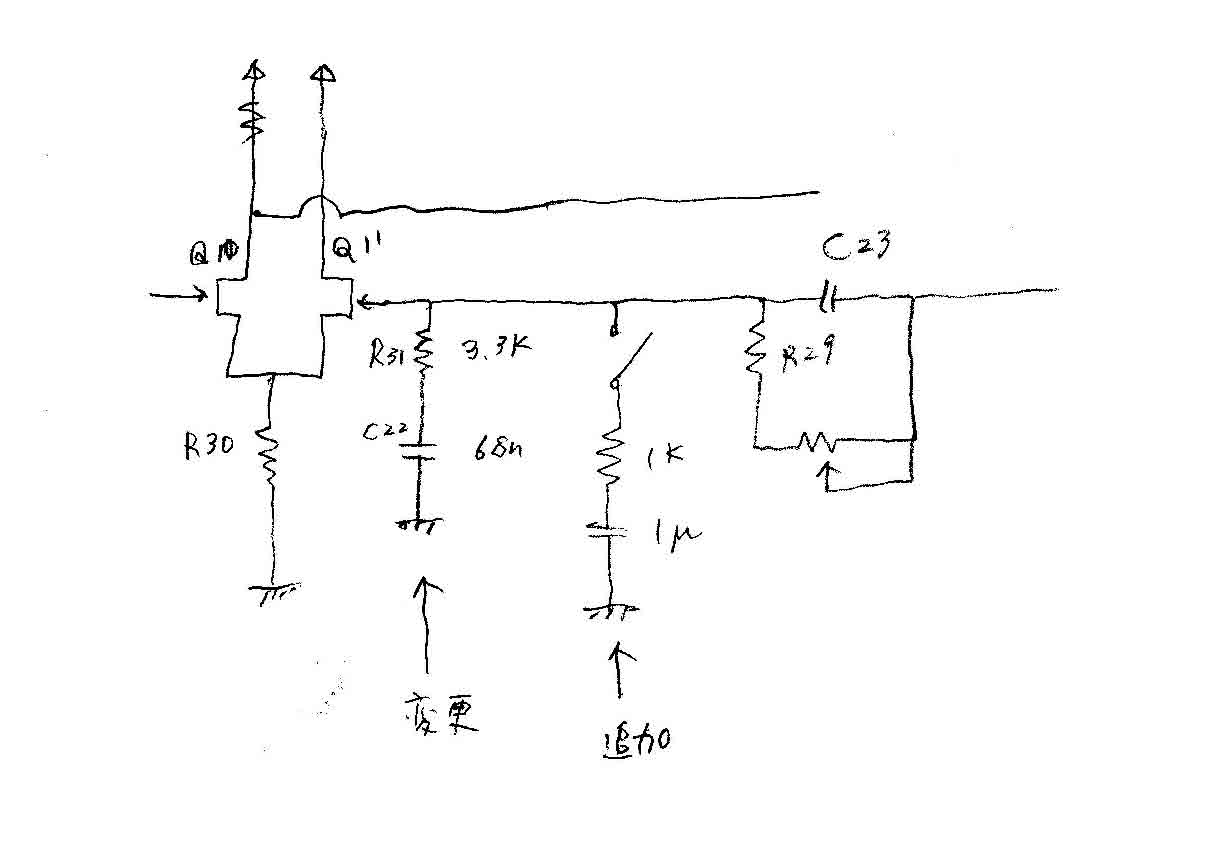またまた続き
日本語訳を期待している方もおられる?

どうなんだろ?
Boss BD-2 Mods & Analysis
Boss BD-2の改造と回路の解析
勝手に訳させていただくので信じないでね
I like germanium OA9s for D7 and D9 because they have a very low Vf of 0.22V, with much less leakage than most germaniums. I used silicon 1N4001s for D8 and D10, because along with zero leakage, they have a slightly lower Vf than most silicons (0.55V), and I typically like their sound in diode shunt clippers.
D7とD9のゲルマニウムOA9は、0.22Vという非常に低いVfを持ち、ほとんどのゲルマニウムよりも漏れ電流がはるかに少ないため、私は好きです。 D8とD10にはシリコン1N4001を使用しました。これは、漏れ電流がゼロであり、ほとんどのシリコン(0.55V)よりもVfがわずかに低く、何より私がこのダイオードクリッパーのサウンドが好きだからです。
Some other germanium choices:
他のゲルマニウムダイオードの選択
1N270s – 0.25Vf, fairly low leakage
New-manufacture ‘workalike’ 1N34As – 0.26Vf (varies), very low leakage because they’re often not actually germanium
D9Es (0.26-0.28Vf) enormous soft knee but horrendous leakage (these are the Soviet diode that people like in Klon clones)
NOS 1N60s (0.3Vf) higher Vf and graceful clipping but also bad leakage
1N695 0.29Vf, leakage is ok but still worse than OA9s and 1N270s
1N270s-0.25Vf、かなり低い漏れ電流
新製造の「同じような」1N34As-0.26Vf(さまざま)、実際にはゲルマニウムではないことが多いため、漏れ電流が非常に少ない
D9Es(0.26-0.28Vf)巨大なソフトニーですが、恐ろしい漏れ電流です(これらは、Klonのクローンで好まれるソビエトダイオードです)
NOS 1N60s(0.3Vf)は高いVfと優雅なクリッピングだけでなく、漏れ電流も悪い
1N695 0.29Vf、漏れ電流は問題ありませんが、OA9および1N270よりも劣る
クリッピングスレショルド
The clipping threshold of the stock network is about 2.2Vpp (which is reasonable in a normal design), but the signal is especially low at that point because of the insertion loss of the high-impedance ‘tone stack’ circuit. It requires quite a bit of gain from the first opamp to reach the stock threshold, by which point the 2nd opamp is into fuzz territory. The 2x OA9-4001 network yields about 1.55Vpp, quite a bit lower – starting to softly clip the peaks before the modified second opamp starts to clip more aggressively, but maintaining clean boost-style operation at lower gain levels.
ストックの回路でのクリッピングスレショルド値は約2.2Vpp(通常の設計では妥当です)ですが、高インピーダンスの「トーンスタック」回路の挿入損失のため、信号はその時点で特に低くなっています。ストックスレショルド値に達するには、最初のオペアンプからかなりのゲインが必要です。その時点で、2番目のオペアンプはファズ領域にあります。 2x OA9-4001ネットワークの出力は約1.55Vppで、かなり低い–変更された2番目のオペアンプがより積極的にクリップを開始する前にピークをソフトにクリップし始めますが、低いゲインレベルでクリーンなブーストスタイルの動作を維持します。
非対称クリッピングモードの追加
I added a switchable ‘asymmetry mode’ that shorts out one of the 4001s so that the positive-going threshold is only the 0.22V of a single OA9, yielding a total headroom of about 1Vpp. In this mode, bass seems a little attenuated because of the heavier loading of the single OA9 with no silicon beneath it, and perceived gain drops somewhat because of the limiting before the 2nd opamp clips. But it has a beautiful compressed feel to it, that preserves more of the guitar’s clean harmonics – with an even softer response than the symmetrical network, and virtually none of the spitty decay of the stock pedal.
私は、4001の1つを短絡する切り替え可能な「非対称モード」を追加しました。これにより、正のしきい値が単一のOA9の0.22Vのみとなり、合計のヘッドルームが約1Vppになります。このモードでは、単一のOA9の下にシリコンがないため負荷が重いため、低音は少し減衰しているように見え、2番目のオペアンプクリップの前の制限により、知覚されるゲインは多少低下します。しかし、美しい圧縮感があり、対称的なネットワークよりもさらにソフトなレスポンスで、ギターのクリーンなハーモニクスを多く維持し、ストックペダルのつまらない減衰はほとんどありません。
BASS RESPONSE
低音のレスポンス
Even the stock circuit attenuates bass a little. If this bothers you, or if you’ve opted to go with all germanium in the clipping stage and there’s no longer enough bass, you can modify the low end. A lot of mods suggest changing the input coupler or the tone stack caps, but these have almost nothing to do with the bass response of the pedal. C27 is the only coupler with any significant roll-off: a highpass at 72Hz, which would only affect downtuned or baritone instruments. You can change it to 47nF to make it full range.
ストックの回路でも低音を少し減衰させます。これが気になる場合、またはクリッピングステージですべてのゲルマニウムを使用することを選択していて、十分な低音がない場合は、ローエンドを変更できます。多くのModは入力コンデンサーまたはトーンスタックコンデンサーの変更を提案していますが、これらはペダルの低音応答とはほとんど関係ありません。
C27(2.2nF)が、重要なロールオフを備えた唯一のコンデンサーです。
ダウンチューニングまたはバリトン楽器にのみ影響する72Hzのハイパスです。 47nFに変更してフルレンジにすることができます。(3.4Hz)
低音の損失をカバーする
The large majority of the bass loss happens via gainstaging. The biggest attenuation is in the negative feedback ground reference of the first opamp (R31-C22). The stock network here is 1.5k-150nF, which creates a highpass at 700Hz! That’s necessary to keep the distortion from turning into a farty mess, but it’s nice to have a LITTLE fundamental in there, especially if you play a baritone instrument. The idea here is not to change the corner frequency of the filter, but to shelve up the lows a little so that they’re not entirely rolled off.
低音の損失の大部分は、ゲインステージングによって発生します。最大の減衰は、最初のオペアンプ(R31-C22 1.5k-0.15uF)の負帰還接地基準です。ここのストックネットワークは1.5k〜150nFで、700Hzでハイパスを作成します。
歪みが乱雑にならないようにするために必要ですが、特にバリトン楽器を演奏する場合は、Bassを少しそこに加えておくと良いです。
ここでの考え方は、フィルターのカットオフ周波数を変更することではなく、低域を少し棚上げして完全にロールオフしないようにすることです。
回路の変更
I changed R31-C22 to 3.3k-68nF, which maintains roughly the same corner frequency but drops the gain by about 7dB. I then added a switchable 10k-10uF R-C series network in parallel with them, which when in-circuit shelves up the lows below 150Hz and returns the gain to stock levels (remember that high frequencies will pass through both networks). The same treble shape is maintained in either mode. With this network, turning the gain all the way down and setting the volume and tone knobs to noon results in a sound indistinguishable from bypass. Turning up the gain does get unruly much faster than stock (make it switchable!),
R31-C22を3.3k-68nFに変更しました。これにより、ほぼ同じカットオフ周波数が維持されますが、ゲインが約7dB低下します。次に、切り替え可能な10k-10uF R-C(編注:多分間違い・でも信じないでね:1K-1uF)を直列にしてR31-C22と並列に追加しました。これにより、回路内で150Hz未満の低域が棚上げされ、ゲインがストックレベルに戻ります(高周波は両方のネットワークを通過することに注意してください)。
どちらのモードでも同じ高音域のサウンドシェイプが維持されます。このネットワークでは、ゲインを一番下まで下げ、ボリュームとトーンのノブを12時に設定すると、バイパスと区別がつかないサウンドになります。ゲインを上げると、ストックよりもはるかに速くなります(切り替え可能にしてください!)ただし、中域には、きれいなエッジのクリーントーンがあり、クリーンアンプには非常にタッチセンシティブです。適度なボリュームで、他のオーバードライブペダルをプッシュするためのブースターとしても役立ちます。
多分こういうこと


信じないでね


